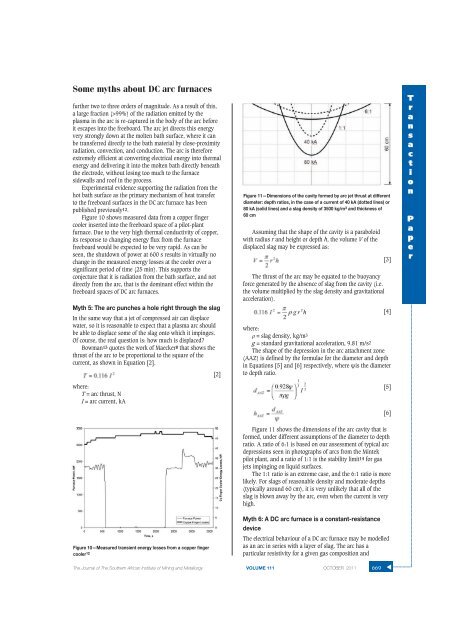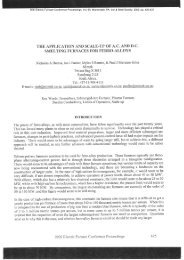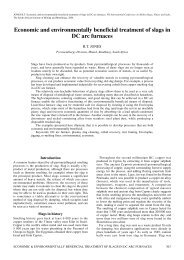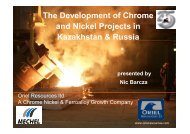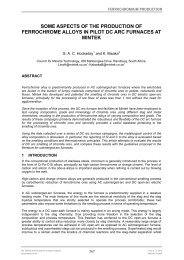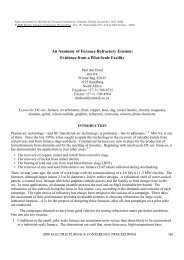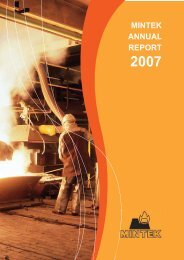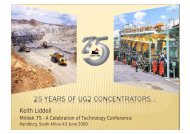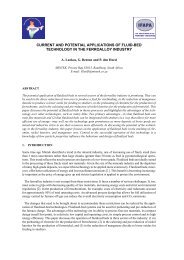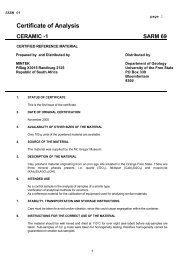Some myths about DC arc furnaces - Mintek
Some myths about DC arc furnaces - Mintek
Some myths about DC arc furnaces - Mintek
You also want an ePaper? Increase the reach of your titles
YUMPU automatically turns print PDFs into web optimized ePapers that Google loves.
<strong>Some</strong> <strong>myths</strong> <strong>about</strong> <strong>DC</strong> <strong>arc</strong> <strong>furnaces</strong>further two to three orders of magnitude. As a result of this,a large fraction (>99%) of the radiation emitted by theplasma in the <strong>arc</strong> is re-captured in the body of the <strong>arc</strong> beforeit escapes into the freeboard. The <strong>arc</strong> jet directs this energyvery strongly down at the molten bath surface, where it canbe transferred directly to the bath material by close-proximityradiation, convection, and conduction. The <strong>arc</strong> is thereforeextremely efficient at converting electrical energy into thermalenergy and delivering it into the molten bath directly beneaththe electrode, without losing too much to the <strong>furnaces</strong>idewalls and roof in the process.Experimental evidence supporting the radiation from thehot bath surface as the primary mechanism of heat transferto the freeboard surfaces in the <strong>DC</strong> <strong>arc</strong> furnace has beenpublished previously12.Figure 10 shows measured data from a copper fingercooler inserted into the freeboard space of a pilot-plantfurnace. Due to the very high thermal conductivity of copper,its response to changing energy flux from the furnacefreeboard would be expected to be very rapid. As can beseen, the shutdown of power at 600 s results in virtually nochange in the measured energy losses at the cooler over asignificant period of time (25 min). This supports theconjecture that it is radiation from the bath surface, and notdirectly from the <strong>arc</strong>, that is the dominant effect within thefreeboard spaces of <strong>DC</strong> <strong>arc</strong> <strong>furnaces</strong>.Myth 5: The <strong>arc</strong> punches a hole right through the slagIn the same way that a jet of compressed air can displacewater, so it is reasonable to expect that a plasma <strong>arc</strong> shouldbe able to displace some of the slag onto which it impinges.Of course, the real question is: how much is displaced?Bowman13 quotes the work of Maecker8 that shows thethrust of the <strong>arc</strong> to be proportional to the square of thecurrent, as shown in Equation [2].where:T = <strong>arc</strong> thrust, NI = <strong>arc</strong> current, kA[2]Figure 11—Dimensions of the cavity formed by <strong>arc</strong> jet thrust at differentdiameter: depth ratios, in the case of a current of 40 kA (dotted lines) or80 kA (solid lines) and a slag density of 3500 kg/m 3 and thickness of60 cmAssuming that the shape of the cavity is a paraboloidwith radius r and height or depth h, the volume V of thedisplaced slag may be expressed as:The thrust of the <strong>arc</strong> may be equated to the buoyancyforce generated by the absence of slag from the cavity (i.e.the volume multiplied by the slag density and gravitationalacceleration).[3][4]where:ρ = slag density, kg/m3g = standard gravitational acceleration, 9.81 m/s2The shape of the depression in the <strong>arc</strong> attachment zone(AAZ) is defined by the formulae for the diameter and depthin Equations [5] and [6] respectively, where ψis the diameterto depth ratio.[5][6]TransactionPaperFigure 10—Measured transient energy losses from a copper fingercooler 12Figure 11 shows the dimensions of the <strong>arc</strong> cavity that isformed, under different assumptions of the diameter to depthratio. A ratio of 6:1 is based on our assessment of typical <strong>arc</strong>depressions seen in photographs of <strong>arc</strong>s from the <strong>Mintek</strong>pilot plant, and a ratio of 1:1 is the stability limit14 for gasjets impinging on liquid surfaces.The 1:1 ratio is an extreme case, and the 6:1 ratio is morelikely. For slags of reasonable density and moderate depths(typically around 60 cm), it is very unlikely that all of theslag is blown away by the <strong>arc</strong>, even when the current is veryhigh.Myth 6: A <strong>DC</strong> <strong>arc</strong> furnace is a constant-resistancedeviceThe electrical behaviour of a <strong>DC</strong> <strong>arc</strong> furnace may be modelledas an <strong>arc</strong> in series with a layer of slag. The <strong>arc</strong> has aparticular resistivity for a given gas composition andThe Journal of The Southern African Institute of Mining and Metallurgy VOLUME 111 OCTOBER 2011 669▲


